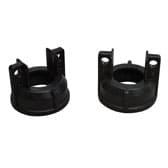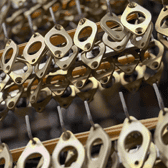Why Cadmium Plating Remains Unbeaten in Wear and Tear Protection
Comments Off on Why Cadmium Plating Remains Unbeaten in Wear and Tear ProtectionIndustries have always looked for ways to protect their important equipment or components from wear and tear caused by harsh conditions and corrosion. One method that has stood the test of time is cadmium plating.
Cadmium is a soft, bluish-white metal found naturally in the Earth’s crust, often with zinc and other minerals. Through electroplating, a thin layer of cadmium metal is applied to the surface of another metal or substrate. This creates a protective coating that shields the underlying material from corrosion, wear, and other environmental hazards.
Lets take a closer look into cadmium plating, its properties and historical significance, and the key considerations for its application.
A Brief Historical Perspective on Cadmium Plating
Cadmium plating has been around for over a century. It was discovered in 1817 by Friedrich Stromeyer, a German chemist. However, its application in industrial processes was only realized when electroplating techniques were introduced in the late 19th century.
The use of cadmium plating gained significant attention and traction during World War I. It was utilized to protect various military equipment, such as aircraft and weaponry, from corrosion. This wartime application highlighted cadmium’s effectiveness in harsh environments. After World War I, it became more widely adopted in various industries and has since become a preferred choice for applications where longevity is paramount.
The Science Behind Cadmium Platings Durability
Cadmium plating’s unparalleled wear and tear protection can be attributed to its unique metallurgical properties. At its core, cadmium is a highly corrosion-resistant metal. When applied, it forms a dense and durable barrier on the substrate’s surface. This barrier effectively shields the underlying material from environmental factors such as moisture, chemicals, and abrasion.
One remarkable aspect of cadmium plating is its ability to self-heal. When minor damage occurs to the plating layer, cadmium ions migrate to the damaged area, sealing the breach. This self-repair mechanism helps maintain the integrity of the protective layer.
The metal’s unique electrochemical properties also significantly influence its corrosion resistance. When it comes into contact with moisture or corrosive substances, cadmium forms a protective layer of cadmium oxide. This acts as a sacrificial barrier, preventing further corrosion of the underlying material.
Applications Across Industries
The versatility of cadmium plating is another reason for its enduring popularity. Here are some key industries where it excels:
- Aerospace: Components in the aerospace industry must withstand extreme conditions and maintain structural integrity. Cadmium plating helps protect critical aircraft parts from corrosion and wear, ensuring passenger safety and operational reliability.
- Automotive: Cadmium plating is applied to various automotive parts, including fasteners, brakes, and chassis. It ensures the durability, aesthetic longevity, and safety of vehicles on the road.
- Defense: The defense industry relies on cadmium plating to safeguard weapon systems, munitions, and military vehicles. Its corrosion resistance is crucial in maintaining the readiness of military equipment.
- Marine: In marine applications, where exposure to saltwater and harsh environments is constant, cadmium protects components such as ship propellers and offshore drilling equipment.
Considerations When Applying Cadmium Plating
While cadmium offers exceptional protection, its application requires careful consideration. Due to environmental concerns related to cadmium toxicity, some regions have implemented regulations to restrict its use. It is essential to comply with these regulations and explore alternative coatings when necessary.
Additionally, proper surface preparation and adherence to plating standards are vital for achieving the best results. Precise control over plating thickness and quality assurance measures are crucial to ensure the longevity and effectiveness of the protective coating.
Partner With New Method Plating for Your Cadmium Plating Needs
With years of experience offering high-quality cadmium plating services, New Method Plating is the ideal partner for your electroplating needs. Our products are renowned across the eastern seaboard and the Midwest. We hold Nadcap AS7108 certification for cadmium plating and comply with various Mil-Specs, including AMS QQ-P-416, AMS 2400, ISO 4042, and more. Our dedication to excellence ensures that your custom plating project receives the attention to detail it deserves. Moreover, with fast turnaround times, you can rely on us to provide your needs promptly without compromising quality.
Contact us for more information, or request a quote today to discuss your next custom plating project!
The Gold Standard in Metal Preservation: Understanding Zinc Plating’s Prowess
Comments Off on The Gold Standard in Metal Preservation: Understanding Zinc Plating’s ProwessIn terms of metal protection, one method stands above the rest zinc plating. It is a process used to coat metal surfaces with a thin layer of zinc. This involves immersing a metal object in a zinc ions solution and applying an electric current. It is widely employed in various industries to enhance the corrosion resistance of metals, such as steel and iron.
Join us as we explore zinc platings rich origins and key characteristics, highlighting its unrivaled excellence in diverse sectors.
Origins and Evolution of Zinc Plating
During the 19th century, using electrical currents to deposit metal onto conductive surfaces laid the foundation for various electroplating methods, including zinc plating. This technique was utilized to prevent corrosion on iron and steel. Its unique characteristics have led to widespread adoption in industries such as shipbuilding and early automotive manufacturing.
The surge in manufacturing activities and the demand for durable, corrosion-resistant materials during the Industrial Revolution prompted further innovations in electroplating processes. Zinc plating became integral to mass production, offering a practical solution to enhance the longevity of various metal components.
As the 20th century unfolded, technological advancements in materials science and electrochemistry significantly contributed to the evolution of zinc plating. The industry witnessed innovations in plating bath formulations, the introduction of automated plating processes, and the development of more environmentally friendly practices.
In the present day, zinc plating has evolved into a versatile and indispensable technique across numerous industries. Its applications extend beyond traditional uses, with zinc-plated components found in electronic devices, construction materials, and more. In addition, the contemporary emphasis on sustainability has also influenced the evolution of this metal coating method. Modern processes strive to minimize environmental impact, aligning with global awareness of eco-friendly manufacturing practices.
Why Zinc Plating Is Widely Used in Various Industries
Zinc plating offers key characteristics that make it a preferred choice in various industries. Here are its defining features:
Corrosion Resistance
One of the primary benefits of zinc plating is its rust-resistant properties. The zinc coating acts as a sacrificial layer, corroding first to protect the underlying metal from oxidation and rust.
Versatility
Zinc plating protects various metal substrates, such as steel, iron, and aluminum. It finds applications in diverse industries, including automotive, construction, electronics, and hardware.
Cost-Effectiveness
Zinc is an abundant and relatively inexpensive metal. The cost-effectiveness of this metal coating method makes it an attractive option for large-scale manufacturing processes.
Aesthetics
Zinc plating can enhance the appearance of metal surfaces, providing a shiny and aesthetically pleasing finish. This makes it valuable for corrosion protection and improving the overall look of coated components.
Durability
The electroplated zinc layer tightly adheres to the metal substrate, ensuring durability and long-lasting protection. This adhesion is crucial for the effectiveness of the coating, especially in applications with high wear and tear.
Ease of Application
The zinc plating process is relatively straightforward, involving immersion of the metal object in a zinc solution and the application of an electric current. This simplicity contributes to its widespread use in various industrial settings.
Environmental Considerations
Zinc plating tends to have a lower environmental impact than alternative coatings. Modern processes focus on minimizing waste and optimizing resource use, aligning with growing concerns about sustainability.
Compatibility
Zinc plating can be easily combined with other finishes and coatings to achieve desired properties. This adaptability makes it suitable for various manufacturing requirements.
Electrochemical Properties
Zinc being more reactive than many base metals provides effective cathodic protection. It helps prevent the development of corrosion by serving as a sacrificial anode.
Get Top-Notch Metal Finishing From New Method Plating
At New Method Plating, we have upheld a strong commitment to quality and have taken immense pride in our craftsmanship since 1931. As an industry leader in zinc electroplating services, our dedication is reflected in our industry-standard certifications, including ISO 9001:2015, AS9100, Nadcap AS7108. Our products also comply with military standards like ASTM B633, AMS 2402, MIL-STD-171, ASTM F1914, ISO 4042. In addition, we continually upgrade our facilities and equipment to maintain our position as one of the finest specialty platers in the New England region.
Contact us for more information on our products and services, or request a quote today to experience metal finishing that exceeds expectations!






